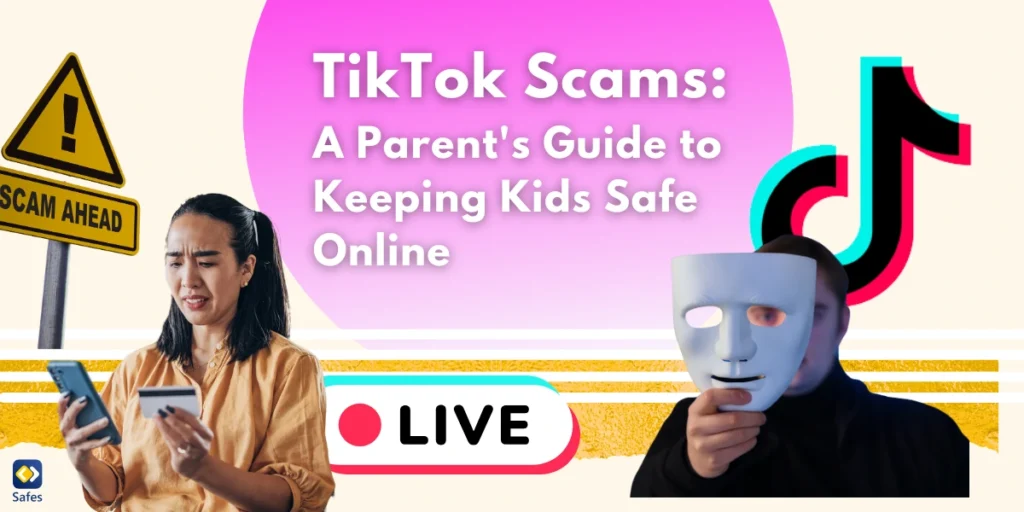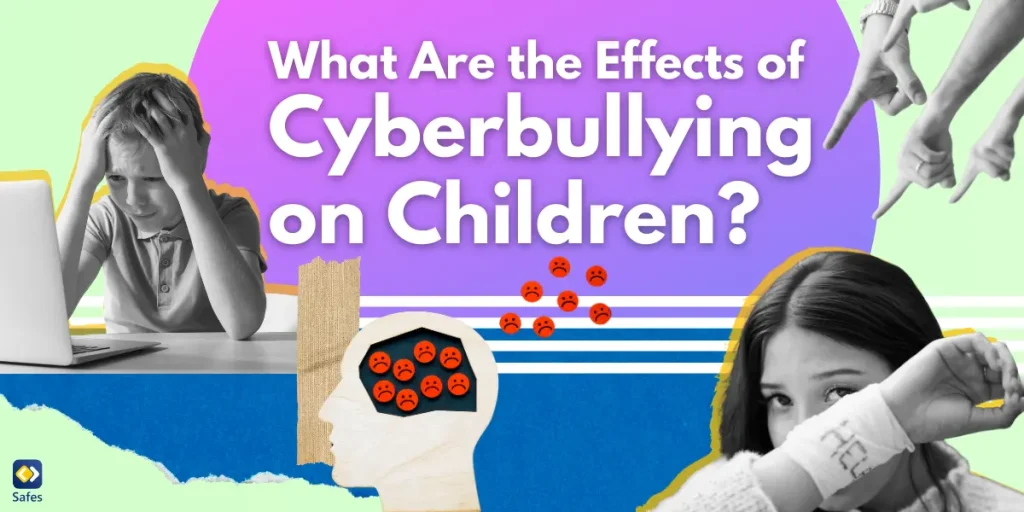TikTok has become one of the most popular social media platforms among kids and teens, offering endless entertainment through short videos, viral challenges, and creative content. However, its popularity has also attracted scammers looking to exploit young, unsuspecting users. From fake giveaways to phishing schemes, TikTok scams pose a real threat to your child’s safety and privacy. In this guide, we’ll explore the most common TikTok scams, how they operate, and what parents can do to prevent their kids from falling victim.
Download and Start Your Free Trial of the Safes Parental Control App
- Tiktok scams list
- scammers on tiktok
- how to report a scammer on tiktok
- fake accounts on tiktok
- tiktok verification email scam
What Is TikTok?
TikTok is a social media platform where users create, share, and discover short-form videos. Known for viral dance trends, comedy skits, and educational content, TikTok has become a global sensation with millions of active users. The platform uses a sophisticated algorithm to recommend videos based on user behavior, preferences, and interactions. This makes content discovery seamless but can also expose users to inappropriate material.
TikTok’s appeal lies in its interactive features, including duets, challenges, and filters. These tools encourage creativity but also open the door to potential risks if misused. For parents, understanding what TikTok is and how it works is the first step in guiding their kids toward safe and responsible usage.
The Digital Playground for Fraudsters
TikTok scams come in many shapes and forms, but they all share one common goal: to exploit trust and manipulate users into revealing personal information or sending money. Many scammers on TikTok create fake profiles or impersonate popular influencers to gain trust and exploit young users for financial or personal gain. One of the most common scams is fake giveaways, where accounts claim users can win expensive items like iPhones or gift cards if they click a suspicious link or provide personal information. Another prevalent scam is phishing, where scammers trick users into sharing login credentials via fake login pages. Parents should warn their children about the TikTok verification email scam, where scammers send fake emails claiming to verify accounts but instead steal login credentials.
Kids and teens are often more vulnerable to these scams because they may not fully understand the risks involved or recognize the warning signs. The platform’s emphasis on fun and social interaction can make young users overlook suspicious behavior. Additionally, scammers often use fake celebrity accounts or impersonate popular influencers to gain credibility and trick their victims.
Understanding how these scams operate is the first step in protecting your child. Parents need to stay informed about the latest trends in online scams and have open conversations with their kids about the dangers lurking behind seemingly harmless videos and messages.
The Most Common TikTok Scams Targeting Kids and Teens
Several types of scams are prevalent on TikTok, each targeting kids and teens in different ways. Fake giveaways are perhaps the most well-known, where scammers promise high-value rewards in exchange for personal details or money. These scams often rely on urgency, pressuring users to act quickly before the ‘offer’ expires.
Another common scam is fake influencer promotions. Scammers create fake profiles impersonating well-known TikTok influencers and promote bogus products or services. Young users, eager to imitate their favorite influencers, may purchase these fake products or share sensitive information.
Phishing scams are also rampant on TikTok. Cybercriminals often send malicious links through direct messages, claiming users need to log in to verify their accounts or claim prizes. Clicking on these links can compromise personal data, including passwords and payment information. Lastly, ‘money flipping’ scams target teens by promising quick cash through investments or cryptocurrency. These scams often sound too good to be true—and they are.

Why Are Kids and Teens Vulnerable to TikTok Scams?
Children and teenagers are naturally more trusting and less experienced in identifying online fraud. They may not understand the value of personal information or the consequences of sharing it with strangers. Additionally, peer pressure and the desire for social validation often drive young users to participate in viral trends and giveaways without questioning their legitimacy.
TikTok’s algorithm also plays a role in amplifying scams. Suspicious content can sometimes go viral before moderators or algorithms detect and remove it. Scammers are quick to exploit trends and use popular hashtags to reach a wider audience.
Another vulnerability lies in parental oversight. Many parents are unfamiliar with TikTok’s platform and features, making it difficult for them to monitor their child’s activity effectively. Open communication, combined with parental controls, can bridge this gap and empower both parents and children to navigate the platform safely.
How to Identify TikTok Scams: Red Flags to Watch For
Recognizing scams on TikTok requires a keen eye for red flags. One common sign is urgency—scammers often pressure users to act quickly, claiming limited-time offers or exclusive deals. Another red flag is suspicious links, especially those that direct users to external websites asking for login credentials or payment details.
Fake accounts are also a major red flag. These accounts may have usernames that closely mimic legitimate influencers but with slight misspellings or extra characters. Additionally, a lack of verified badges on high-profile accounts should raise suspicion.
Parents should also teach kids to be wary of unsolicited direct messages, especially those asking for personal information or promoting unbelievable deals. Encouraging children to approach parents with any suspicious interactions can create a safety net.
Parental Strategies for Protecting Kids from TikTok Scams
Protecting your child from TikTok scams starts with education and communication. Teach your kids about the risks of sharing personal information online and explain how scammers operate. Also beware of TikTok addiction in your child. Encourage them to approach you if they encounter anything suspicious.
Use TikTok’s parental control features to monitor and limit your child’s activity. TikTok offers a Family Pairing feature, allowing parents to link their accounts with their child’s and set safety restrictions, such as limiting direct messages and screen time.
Regularly review your child’s follower list and account activity. Teach them to avoid interacting with suspicious profiles and not to click on unknown links. Additionally, ensure your child uses a strong, unique password for their TikTok account.
Open Communication: Building Trust with Your Child
Trust is the foundation of online safety. Creating an open and non-judgmental environment where your child feels comfortable discussing their online experiences is crucial. If they encounter a scam or suspicious activity, they should know they can come to you without fear of punishment.
Discuss real-life examples of TikTok scams to illustrate the potential risks. Storytelling can be an effective way to make these lessons memorable and impactful. Make online safety an ongoing conversation rather than a one-time lecture. As new threats emerge, keep your child informed and involved in proactive safety practices. Blocking TikTok via third-party apps should be the ast resort.
How to Report a Scam on TikTok
If you suspect fraudulent activity, it’s essential to know how to report a scammer on TikTok by navigating to the user’s profile, selecting the report option, and providing the necessary details. TikTok has built-in reporting features that allow users to flag suspicious accounts, messages, or content.
To report a scam, navigate to the offending profile or message, click the three-dot menu, and select ‘Report.’ Follow the prompts to describe the issue. TikTok’s moderation team will review the report and take appropriate action.
Additionally, block the scam account to prevent further interaction. Encourage your child to notify you whenever they encounter anything suspicious so you can take the necessary steps to block them together.
How Parental Control Apps Can Help With Scams
Parental control apps offer valuable tools for protecting children from scams on TikTok, apart from TikTok’s parental controls. These apps can monitor online activity, filter suspicious content, and send alerts when unusual behavior is detected. Some kids hide TikTok. By using these tools, parents can gain better visibility into their child’s interactions on the platform.
Many parental control apps offer features such as screen time management, content blocking, and message monitoring. These tools help prevent children from encountering scam accounts or clicking on harmful links.
In addition to monitoring and tracking TikTok, these apps can also educate kids about online safety. Some apps include resources and interactive lessons on recognizing scams and practicing safe online habits. Parental control apps are not a substitute for open communication, but they can serve as a strong layer of defense in protecting kids from TikTok scams.
Pros and Cons of TikTok for Kids and Teens
Some of the pros of TikTok include:
- Creative Expression: TikTok offers a unique platform for kids and teens to express themselves creatively through short videos, music, and editing tools. From dance challenges to educational content, it encourages artistic exploration and digital skills.
- Community and Connection: The app fosters a sense of community by allowing users to connect with others who share similar interests. Teens can follow creators, participate in challenges, and feel a sense of belonging in niche communities.
- Learning Opportunities: TikTok isn’t just about entertainment—it’s also a hub for educational content. Many creators share valuable lessons in science, history, and life skills, making learning fun and engaging.
- Potential for Fame and Opportunities: The platform provides visibility for talented individuals, sometimes even leading to career opportunities, collaborations, and brand deals.
Some of the cons of TikTok include:
- Exposure to Inappropriate Content: Despite TikTok’s moderation efforts, inappropriate or explicit content can still slip through filters, exposing children to harmful material.
- Privacy Concerns: TikTok collects a significant amount of user data, raising concerns about how this data is stored, shared, and protected. Younger users may not fully understand the implications of sharing personal information.
- Addictive Nature: The endless scrolling and algorithm-driven recommendations can make TikTok highly addictive, leading to excessive screen time and a decline in productivity and focus.
- Online Scams and Cyberbullying: From fake giveaways to phishing attempts, scams are rampant on the platform. Additionally, negative comments and cyberbullying can have a lasting emotional impact on young users.
Conclusion
TikTok is a fun and engaging platform for kids and teens, but it also comes with risks. Scammers are constantly evolving their tactics, and staying informed is your best defense. Parents should familiarize themselves with a TikTok scams list to understand the most common tactics scammers use, such as fake giveaways, phishing links, and impersonation accounts. By educating your children, using parental controls, and fostering open communication, you can create a safer online experience for your family. Remember, online safety is a shared responsibility, and with the right tools and awareness, you can protect your child from falling victim to TikTok scams.
Protect your child’s online experience with Safes Family, the ultimate parental control app available on iOS and Android. Easily monitor screen time, filter inappropriate content, and ensure your child’s safety on platforms like TikTok. Start your free trial today and gain peace of mind while your child explores the digital world responsibly.
Your Child’s Online Safety Starts Here
Every parent today needs a solution to manage screen time and keep their child safe online.
Without the right tools, digital risks and excessive screen time can impact children's well-being. Safes helps parents set healthy boundaries, monitor activity, and protect kids from online dangers—all with an easy-to-use app.
Take control of your child’s digital world. Learn more about Safes or download the app to start your free trial today!




